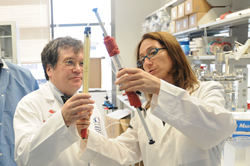Oral, head and neck cancer and HPV: What you should know
Once exclusively associated with risk factors like alcohol and tobacco use, research finds that as many as 70 percent of head and neck cancers occurring in the tonsils and the base of the tongue are due to human papilloma virus infection (HPV), according to the U.S. Centers for Disease Control and Prevention.
As we recognize Oral, Head and Neck Cancer Awareness Week, which kicked off April 10, Dr. Robert Ferris, chief of the division of head and neck surgery at the University of Pittsburgh Cancer Institute and Dr. Andrew Sikora, vice chair for research and co-director of Baylor College of Medicine’s Head and Neck Cancer Program, discuss oropharyngeal cancer prevention and treatment.
The following Q&A was part of the Second Annual Bobby R. Alford, M.D., Grand Rounds Distinguished Lecture, presented by Ferris.
Q: What is oropharyngeal cancer?

Ferris: Cancers can occur in different areas of the head and neck, including the mouth, the throat and the voice box. Oropharyngeal cancer is generally meant to represent cancer in the tonsil and the back of the tongue, where the additional tonsil tissue exists. That tissue seems to be particularly hospitable to the human papilloma virus and so we think of that as a unique disease, oropharyngeal carcinoma.
Q: What are the signs and symptoms of oropharyngeal cancer?
Ferris: This is a difficult question because the signs and symptoms are very nonspecific, and sometimes there really aren’t any symptoms. Symptoms may include trouble swallowing, sore throat or ear pain but those things can happen for lots of people who don’t have cancer. Usually patients with oropharyngeal cancer experience a lump in the neck and that leads to visit to the doctor and eventually a diagnosis of this type of cancer. If you have any of those symptoms and a lump in the neck, or none of those symptoms and a lump in the neck you should see your doctor. In other words, see your doctor if you have a lump in your neck.
Q: What causes oropharyngeal and other types of head and neck cancers?
Sikora: Head and neck squamous cell carcinoma, which is the most common head and neck cancer, traditionally was primarily caused by tobacco and alcohol consumption. However, over the past decade to decade and a half, HPV has become a much more important cause of head and neck cancer, and it is uniquely associated with the oropharynx. There’s something special about the oropharynx that HPV really likes and tends to cause cancer there.
Q: HPV also causes cervical cancer, so is it the same virus?
Ferris: The answer is partially yes. There are more than 100 subtypes of HPVs. The most common subtype that causes cervical cancer is only responsible for only half of all cervical cancers. That is type 16, and that type is also responsible for 95 percent of head and neck cancer. But with cervical cancer half of those cases are formed by lots of different HPV subtypes that we don’t really see as much in the head and neck cancers.
Sikora: Yes, in the oropharyngeal cancer there is a much smaller subset of HPV types that seem to be involved, with type 16 being the most common. But we also find a small number of other types that consistently come up as well.
Q: How is HPV-causing oropharyngeal cancer transmitted from person to person?
Ferris: The honest fact is that we’re not exactly sure. HPV is a very hardy virus, so it’s lying around and you can get it through casual contact with surfaces. There are a number of skin cancers that can be caused by HPV, indicating that it doesn’t just require sexual contact or interaction. It is not clear what contribution intimate versus nonintimate sexual contact or human contact contributes but clearly the virus is around and gets transmitted by human contact since all of us have been exposed. At least 80 percent of people have been exposed by their mid-20s.
Q: If so many people are exposed, how come only some people get cancer?
Sikora: We’re both immunologists so we’re likely to tell you that part of it is differences in the immune systems of people who are exposed to the virus. When you are exposed to the virus your immune system can recognize it and clear it or it can persist. And the exact factors that determine what happens in an individual person aren’t all known. We’ve actually looked at this using data from something called GWAS, which is a genome-whole association study where we look at immune genes that contribute to risks of HPV-related cancers. We found that there actually are some mutations that can contribute to that risk but we know that explains only part of the risk.
Ferris: Some other scientists have suggested that having an exposure or an active infection during a time of trauma creating an injury to the lining of the cervix, in that case, or to the throat may provide access to the virus to deeper layers of tissues and cells that may be more hospitable to infection and so if you were exposed but not have any injured areas of the lining perhaps you would be more resistant. But people aren’t exactly sure.
Q: Will the FDA-approved HPV vaccines prevent oropharyngeal cancer?
Ferris: There are two answers to that; answer number one is that having a vaccine is not going to prevent cancer if people don’t get it, boys and girls included. So the first answer is, it might be effective for preventing it but first we have to vaccinate people. We have a product that is effective for cervical pre-malignant lesions, but is it effective for oral pre-malignant lesions? The only real data that we have for that comes from a Costa Rican study where saliva was collected from a group of young women who were randomized to Hepatitis A vs HPV prevention. Researchers were looking at cervical lesions but they happened to have saliva four years later and found that the presence of HPV DNA in the saliva was almost nonexistent in the group that got the HPV vaccine vs. those who got the Hepatitis A vaccine. This suggests that you could prevent what we think is a biomarker of oropharyngeal cancer risk, which is the presence of DNA in the saliva.
Sikora: It’s a little indirect but still convincing because of everything we know about how the virus persists and how it interacts with the immune system. But it’s must easier to do those studies with cervical cancer than in oropharyngeal cancer because in cervical cancer there are actually pre-malignant lesions. So in cervical cancer you can examine a patient and show that these pre-malignant lesions are less common in vaccinated people, and with head and neck cancer of the oropharynx we don’t really have that. We don’t have a similar way to monitor people who don’t actually get full-blown cancer.
Ferris: There’s no Pap smear. Brushing the oropharynx doesn’t seem to help.
Q: Should males get the HPV vaccination?
Sikora: I think yes. It is FDA approved, and if I had a son, I would certainly vaccinate him.
Ferris: We have been relying on what we would call herd immunity, meaning if we can eliminate it from high enough fraction of females, that we would then get rid of it in males. I think that is probably naive. I think this sort of virus has been around long enough that we will have to target males and females to truly get rid of the high-risk HPV types that cause cancer.
Sikora: It’s important to note that HPV-related oropharyngeal cancer is largely a disease of men. It occurs in women, too, but by far it is more common in men.
Additional Resources
To schedule a visit with a Baylor otolaryngologist, call 713-798-5900 or request an appointment online.
Preventing head and neck cancers with the HPV vaccine
Four things to know about head and neck cancer: Are you at risk?
Your immune system: The secret weapon against HPV-related cancers




Thanks for sharing.
Pingback: Know your risk for developing head and neck cancer